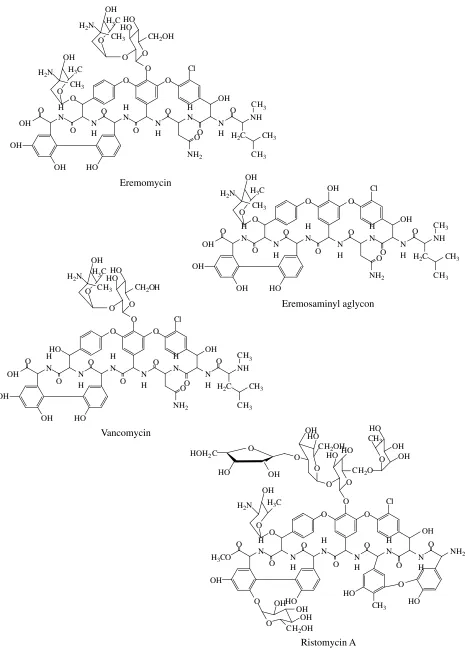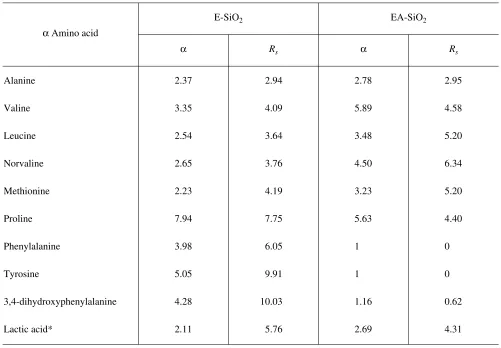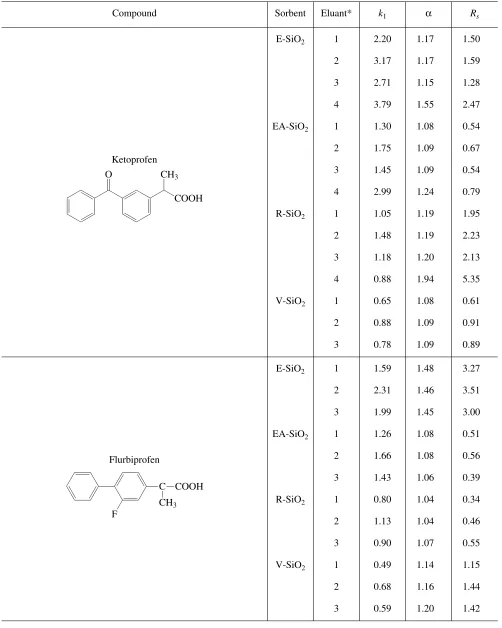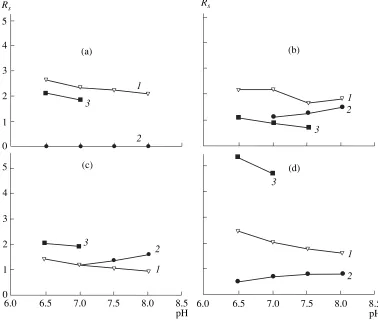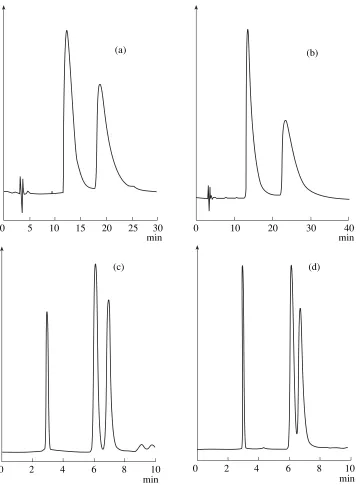ISSN 0003-6838, Applied Biochemistry and Microbiology, 2006, Vol. 42, No. 6, pp. 536–544. © MAIK “Nauka /Interperiodica” (Russia), 2006.
Original Russian Text © M.A. Kuznetsov, P.N. Nesterenko, G.G. Vasiyarov, S.M. Staroverov, 2006, published in Prikladnaya Biokhimiya i Mikrobiologiya, 2006, Vol. 42, No. 6, pp. 615–623.
The increasing attention being paid by researchers to studies in the field of stereoselective synthesis and catalysis, as well as methods of chromatographic sepa-ration of chiral phases, observed over the last decade, is due to the requirements of the World Health Organiza-tion for the optical purity of drugs. The lack of univer-sally applicable chiral phases for separating optical iso-mers prompts researchers to develop new sorbents. Immobilized macrocyclic glycopeptide antibiotics (including vancomycin, teichoplanin, ristocetin A, avoparcin, etc.) proved to serve as chiral phases for reli-able HPLC separation of a wide range of drugs [1–4]. The high enantioselectivity of the sorbents belonging to this class is due to the presence of structurally diverse fragments capable of multiple-point interactions with the compounds to be separated (in both polar and non-polar solvents). Immobilization of new antibiotics [5], chemical modifications of their structure [6], and refinement of immobilization techniques [7] offer addi-tional possibilities for changing the enantioselectivity of sorbents belonging to this class.
It was previously shown that eremomycin (a new antibiotic manufactured in Russia), in contrast to its closest structural analogue vancomycin, exhibits high enantioselectivity in separating isomers of α amino acids when immobilized on silica gel [8]. A method of its immobilization was developed that increased the selectivity of the separation, thus, rendering the sorbent
superior to other chiral selectors in separating isomers of α amino acids [9].
In this work, we sought to explore the capacity of the new eremomycin sorbent for separating enanti-omers of other classes (profens) and study the effects of structural modification of eremomycin on its enantiose-lectivity, as compared to the known chiral selectors vancomycin and ristomycin.
MATERIALS AND METHODS
Reagents. The antibiotics were immobilized using
modified silica gels: Diaspher-110-Epoxy (particle size, 6 µm; specific surface, 313 m2/g; pore diameter,
11 nm; carbon content, 5.2%) and Diasorb-130-Epoxy (particle size, 6 µm; specific surface, 280 m2/g; pore
diameter, 13 nm; carbon content, 4.8%) manufactured by BioChemMack ST Russia. The eluants were pre-pared using methanol, acetic acid, and triethylamine (Fluka, Switzerland). Eremomycin and ristomycin were synthesized using a pilot plant at the Hause Insti-tute for New Antibiotics (Russia) [10, 11]. Vancomycin was provided by the joint stock company Veropharm (Russia). The profens and amino acids were purchased from Sigma (United States).
Obtaining eremosaminyl aglycon of eremomycin [4]. Eremomycin (3 g) was dissolved in 30 ml of dime-thyl sulphoxide, and the solution was supplemented with 2 ml of 80% sulfuric acid, after which the mixture
Sorbents with Immobilized Glycopeptide Antibiotics
for Separating Optical Isomers
by High-Performance Liquid Chromatography
M. A. Kuznetsov
a, P. N. Nesterenko
a, G. G. Vasiyarov
a, and S. M. Staroverov
a, ba Faculty of Chemistry, Moscow State University, Moscow, 119899 Russia e-mail: kuznetsovm@rambler.ru
b Joint Stock Company BioChemMack ST, Moscow, 119899 Russia Received January 19, 2006
Abstract—Chiral sorbents for HPLC separation of optical isomers carrying glycopeptide antibiotics (eremo-mycin or its eremosaminyl aglycon, risto(eremo-mycin, or vanco(eremo-mycin) fixed onto the surface of silica gel have been synthesized. The patterns of the retention and separation of profen isomers and their dependence on the nature of the chiral selector and the eluant composition have been studied. The sorbents were shown to be highly enan-tiospecific in separating the isomers of α-amino-, α-hydroxy-, and α-methylphenylcarboxylic acids (profens)
SORBENTS WITH IMMOBILIZED GLYCOPEPTIDE ANTIBIOTICS 537 was heated for 3 h. The target product was separated
chromatographically in a 2.5 × 11.5 cm column packed with Diasorb-130-C16T (particle size, 63–200 µm; BioChemMack ST); aqueous acetonitrile supple-mented with 0.1% trifluoroacetate served as the mobile phase (0–25% acetonitrile gradient). The excess sol-vents were removed using rotary evaporation. The yield of the product was 50%; its purity by HPLC was 87%.
Obtaining silica gel-immobilized eremomycin (E-SiO2). Eremomycin (2 g) was dissolved in 50 ml of
distilled water, and the pH of the solution was adjusted to 8.6 by dropwise addition of 1 M KOH. The solution thus obtained was mixed with 10 g Diaspher-110-Epoxy, and the suspension was heated at 40°ë for 14 h under stirring. Following the completion of the reac-tion, the sorbent was separated by filtrareac-tion, washed (with water, methanol, and acetone, in sequence), and dried at 50°ë for 4 h. The data of the elemental analysis (12.6% C, 2.29% H, 1.2% N) corresponded to an engraftment density of 0.35µmol/m2.
Obtaining silica gel-immobilized eremosaminyl
aglycon of eremomycin (EA-SiO2), ristomycin
(R-SiO2), and vancomycin (V-SiO2). An aliquot (1 g) of a glycopeptide antibiotic was dissolved in a mixture of 15 ml distilled water and 5 ml ethanol. Thereafter, the synthesis was performed as described above for E-SiO2, except that the amount of Diaspher-110-Epoxy
equaled 5 g and Diasorb-130-Epoxy was used for the vancomycin immobilization. The engraftment densi-ties calculated from the data of the elemental analyses (EA-SiO2: 9.1% C, 2.1% H, 1.1% N; R-SiO2: 13.1% C,
1.9% H, 1.6% N; V-SiO2: 8.3% C, 1.6% H, 1.8% N)
correspond to 0.21, 0.3, and 0.2 µmol/m2.
Stainless steel 4 × 250 mm columns were packed with the sorbents using a suspension technique (at 60 MPa). The chromatograph used in the work (Knauer, Germany) consisted of a K-1001 pump, a K-2501 spectrophotometric detector, and a dosing valve with a 20-µl sample loop. The volume of the sam-ple was in the range 5–20 µl. The chromatograms were recorded and the results were processed, including the calculation of the retention (Í), selectivity (a), and res-olution (Rs) factors, using Multikhrom software (Ampersand, Russia). The idle time was determined by loading the column with a toluene solution in methanol and eluting it with methanol (photometric detection was performed at 210 nm).
RESULTS AND DISCUSSION
Figure 1 presents the chemical structures of the immobilized chiral selectors, which show that each selector contains 18–38 chiral centers. It is also clear
from the figure that the selectors differ in the number and type of functional groups capable of participating in chiral recognition of isomers. This variability makes it difficult to understand the mechanism whereby enan-tiomers are separated by macrocyclic glycopeptide antibiotics, in spite of the abundant reports on the sub-ject. For example, sorbents containing teichoplanin, its aglycon, or ristomycin A (ristocetin) are highly selec-tive in separating the isomers of α amino acids, whereas immobilized vancomycin fails to exhibit appreciable enantioselectivity [1].
We were able to previously demonstrate that a sor-bent engrafted with eremomycin (the closest structural analog of vancomycin) exhibited unexpectedly high selectivity in separating enantiomers of α amino acids [8, 9]. It is conceivable that the selectivity of eremomy-cin is due to its differences from vancomyeremomy-cin, such as the absence of a chlorine atom in the aromatic fragment and the presence of an additional aminoglucoside in the carbohydrate portion of the molecule [10]. Moreover, the carbohydrate residue of eremosamine is stere-ochemically different from that of vancosamine in the configuration of the C4 atom [11].
Studies of sorbents containing surface-fixed eremo-mycin analogues are of interest for obtaining an insight into the mechanism of chiral recognition of α amino acids by the eremomycin-engrafted sorbent. In this work, we obtained eremosaminyl aglycon of eremomy-cin (by eremomyeremomy-cin hydrolysis) and synthesized a chiral sorbent containing this compound (EA-SiO2). As
shown in Table 1, the absence of eremosamine in the chiral selector increases its enantioselectivity for α amino acids with aliphatic side chains; however, the separation of isomers of aromatic amino acids is negli-gible. Eremosamine likely plays and important part in the chiral recognition of enantiomers of aromatic amino acids, possibly by virtue of creating ancillary steric effects.
The new chiral phases E-SiO2 and EA-SiO2 are not
limited to separating solely optical isomers of α amino acids. Table 1 contains an example of separation of enantiomers of an α hydroxyacid (lactic acid), whereas Table 2 and Figs. 2 and 3 show the results of separation of isomers of profens (α methyl-substituted acids).
sup-538 KUZNETSOV et al. Eremomycin Eremosaminyl aglycon Vancomycin Ristomycin A OH H N N H H N N H H N N H NH O O O O Cl NH2
H2C CH3
CH3 O
CH2OH O
HO HO H3C OH
H2N
O H3C OH
H2N
CH3 CH3 OH OH HO CH3 O
O O O O
O O O
O OH
H3CO H N N H H N N H H N N H NH2 O O O O Cl O H3C OH
H2N
O OH
HO
O O O O
O O O
CH3 HO
HO O
O
CH2OH OH OH OH
O CH2O
O OH OH HO CH3 HO HO O O
CH2OH O
O
HOH2C
HO OH HO OH OH OH H N N H H N N H H N N H NH O O OH O Cl NH2
H2C CH3
CH3 O
H3C OH
H2N CH3
OH OH
HO
CH3
O O O O
O O O
O OH OH H N N H H N N H H N N H NH HO O O O Cl NH2
H2C CH3
CH3 O
CH2OH O
HO HO H3C OH
H2N CH3 OH OH HO CH3 O
O O O O
O O O
[image:3.612.67.532.53.703.2]O OH
Fig. 1. Structural formulae of immobilized chiral selectors.
SORBENTS WITH IMMOBILIZED GLYCOPEPTIDE ANTIBIOTICS 539
plemented with triethylamine and acetic acid (polar ionic HPLC; PI-HPLC) [2].
Analysis of the results obtained indicates that opti-mum separation of profens is achieved by using eremo-mycin-engrafted silica gel. The selectivity and high res-olution were achieved in both variants (RP-HPLC and PI-HPLC). For all the profens except phenoprofen, the values of Rs achieved under optimum conditions exceeded 1.5, which ensured isomer separation down to the baseline. For phenoprofen, the maximum Rs value equaled 1.42. As a rule, the RP-HPLC setting showed higher values of selectivity and resolution for all the sorbents; however, the peaks were wider than in the PI-HPLC setting (Table 2 and Fig. 3).
Reversed-phase setting. The retention of profens
did not correspond to their lipophilicity, which indi-cated that, in aqueous methanol, the effects of addi-tional, specific interactions with macrocyclic glycopep-tide antibiotics were considerable. A decrease in the
retention of both enantiomers, observed on increasing pH of the eluant, was the general pattern characteristic of RP-HPLC for all the sorbents studied. In the case of
R-SiO2 and E-SiO2, this effect was paralleled by a
decrease in the peak resolution (Rs), although the selec-tivity remained virtually unchanged (Fig. 2). With EA-SiO2, both Rs and α (the enantioselectivity) increased with the pH of the eluant, even though not considerably. Of interest, this sorbent failed to separate enantiomers of indoprofen, which is likely due to the predominantly nonchiral binding of this compound to the graft, at least in aqueous methanol. On the whole, the best results of RP-HPLC separation of indoprofen and ibuprofen were achieved with E-SiO2 (the
maxi-mum values of α equaled 1.99 and 1.70), and those of ketoprofen and phenoprofen, respectively, with R-SiO2 (α 1.94) and EA-SiO2 (α 1.58). Thus, the operational
[image:4.612.47.548.79.427.2]characteristics of our sorbents are superior to those of commercially available phases (such as Chirobiotic) [12–15].
Table 1. Values of the enantioselectivity (α) and resolution (Rs) of columns packed with immobilized eremomycin or its ag-lycon in separating enantiomers of α amino acids (eluant, methanol–water 50 : 50)
α Amino acid
E-SiO2 EA-SiO2
α Rs α Rs
Alanine 2.37 2.94 2.78 2.95
Valine 3.35 4.09 5.89 4.58
Leucine 2.54 3.64 3.48 5.20
Norvaline 2.65 3.76 4.50 6.34
Methionine 2.23 4.19 3.23 5.20
Proline 7.94 7.75 5.63 4.40
Phenylalanine 3.98 6.05 1 0
Tyrosine 5.05 9.91 1 0
3,4-dihydroxyphenylalanine 4.28 10.03 1.16 0.62
Lactic acid* 2.11 5.76 2.69 4.31
540 KUZNETSOV et al.
Table 2. Values of the retention (κ), enantioselectivity (α), and resolution (Rs) factors characterizing profen separation under the conditions of polar ionic (eluants 1–3) and reversed-phase (eluant 4) HPLC
Compound Sorbent Eluant* k1 α Rs
Phenoprofen
E-SiO2 1 1.48 1.12 0.93
2 2.02 1.11 1.01
3 1.99 1.11 0.89
4 4.18 1.32 1.42
EA-SiO2 1 0.81 1.17 1.19
2 1.04 1.18 1.39
3 0.99 1.17 1.14
4 3.28 1.58 1.59
R-SiO2 1 0.71 1.08 0.76
2 0.93 1.09 0.91
3 0.89 1.09 0.91
4 0.68 1.29 1.93
V-SiO2 1 0.46 1 0
2 0.60 1 0
3 0.61 1 0
Ibuprofen
E-SiO2 1 0.83 1.28 1.71
2 1.04 1.27 1.85
3 1.27 1.25 1.73
4 3.06 1.70 2.18
EA-SiO2 1 0.54 1.15 0.77
2 0.65 1.15 0.91
3 0.78 1.14 0.80
4 2.83 1.67 1.50
R-SiO2 1 0.37 1 0
2 0.48 1 0
3 0.55 1 0
4 5.16 1.15 1.48
V-SiO2 1 0.26 1 0
2 0.31 1 0
3 0.41 1 0
Indoprofen
E-SiO2 1 2.82 1.28 2.03
2 3.68 1.29 2.14
3 3.87 1.27 1.98
4 2.15 1.99 2.08
EA-SiO2 1 2.29 1.17 1.03
2 2.80 1.17 1.07
3 2.91 1.18 0.86
4 5.95 1 0
R-SiO2 1 1.55 1.07 0.58
2 1.93 1.07 0.72
3 1.95 1.08 0.87
4 1.37 1.27 2.11
V-SiO2 1 0.89 1.06 0.43
2 1.10 1.06 0.52
3 1.17 1.10 0.60
O
COOH CH3
H3C
COOH CH3 CH3
N O
SORBENTS WITH IMMOBILIZED GLYCOPEPTIDE ANTIBIOTICS 541
Table 2. (Contd.)
Compound Sorbent Eluant* k1 α Rs
Ketoprofen
E-SiO2 1 2.20 1.17 1.50
2 3.17 1.17 1.59
3 2.71 1.15 1.28
4 3.79 1.55 2.47
EA-SiO2 1 1.30 1.08 0.54
2 1.75 1.09 0.67
3 1.45 1.09 0.54
4 2.99 1.24 0.79
R-SiO2 1 1.05 1.19 1.95
2 1.48 1.19 2.23
3 1.18 1.20 2.13
4 0.88 1.94 5.35
V-SiO2 1 0.65 1.08 0.61
2 0.88 1.09 0.91
3 0.78 1.09 0.89
Flurbiprofen
E-SiO2 1 1.59 1.48 3.27
2 2.31 1.46 3.51
3 1.99 1.45 3.00
EA-SiO2 1 1.26 1.08 0.51
2 1.66 1.08 0.56
3 1.43 1.06 0.39
R-SiO2 1 0.80 1.04 0.34
2 1.13 1.04 0.46
3 0.90 1.07 0.55
V-SiO2 1 0.49 1.14 1.15
2 0.68 1.16 1.44
3 0.59 1.20 1.42
* 100% CH3OH with supplements: (1) 0.2% (C2H5)3N and 0.2% CH3COOH; (2) 0.1% (C2H5)3N and 0.2% CH3COOH; and (3) 0.2% (C2H5)3N and 0.1% CH3COOH. (4), 40% CH3OH : 60% 0.1 M phosphate buffer.
COOH CH3 O
F
C CH3
[image:6.612.48.550.70.698.2]542 KUZNETSOV et al.
The sorbent with immobilized vancomycin exhib-ited no selectivity for profens in the RP-HPLC setting; its appreciable selectivity under the conditions of PI-HPLC was limited to flurbiprofen, however.
Polar-ionic setting. The use of 100% methanol
sup-plemented with acetic acid and organic bases (e.g., tri-ethylamine) as an eluant makes it possible to suppress the undesirable ion-exchange interactions between the sorbate and the chiral phase (noted when indoprofen enantiomers were separated on EA-SiO2 under the con-ditions of RP-HPLC). As a result, the shape of the chro-matographic peaks is improved, even though the selec-tivity and resolution become less pronounced (Table 2). The separation of indoprofen isomers on EA-SiO2 is an exceptional case, since the value of α increased from 1.0 to 1.17.
As in the case of the RP-HPLC setting, satisfactory separation of profen enantiomers under the conditions of PI-HPLC was achieved with one sorbent, E-SiO2.
Other sorbents could be used for separating one or two sorbates, thus, showing a certain degree of specificity.
For example, the use of R-SiO2 ensured the optimum
separation of racemic ketoprofen, whereas EA-SiO2
and V-SiO2 ensured the optimum separation of racemic phenoprofen and flurbiprofen, respectively.
In conclusion, a silica gel carrying eremomycin (a surface-fixed macrocyclic glycopeptide antibiotic) exhibits high enantioselectivity in separating isomers of α amino and hydroxy acids, as well as enantiomers of various derivatives of 2-arylpropanoic acid (the so-called profens). The operational parameters of this sor-bent are not inferior to those of commercially available analogs. With immobilized ristomycin A as an exem-plary case, it is shown that the proposed method of engraftment increases the enantioselectivity of the sil-ica gel-fixed selector for isomers of α methyl as well as α amino acids (profens).
The values of selectivity achieved under the condi-tions of reversed-phase chromatography suggest that the sorbents can be used for both analytical and prepar-ative separation of profen enantiomers.
Rs
5
4
3
2
1
0
6.0 6.5 7.0 7.5 8.0 8.5
pH
1
2 3
(a) (b)
(c) (d)
2
1 3
3
2 1 3
2 1
6.0 6.5 7.0 7.5 8.0 8.5
pH 5
4
3
2
1
0
[image:7.612.106.484.59.381.2]Rs
SORBENTS WITH IMMOBILIZED GLYCOPEPTIDE ANTIBIOTICS 543
ACKNOWLEDGMENTS
This work was performed as part of project no. 02.467/11/3004 supported by the Russian Federal Agency for Science and Innovations.
REFERENCES
1. Armstrong, D.W., Tang, Y., Chen, S., Zhou, Y., Bag-will,C., and Chen, J.R., Anal. Chem., 1994, vol. 66, pp. 1473–1484.
2. Armstrong, D.W., Liu, Y., and Ekborg-Ott, K.H., Chiral-ity, 1995, vol. 7, pp. 474–497.
3. Ekborg-Ott, K.H., Liu, Y., and Armstrong, D.W., Chiral-ity, 1998, vol. 10, pp. 434–483.
4. Ekborg-Ott, K.H., Kullman, J.P., Wang, X., Gahm, K., He, L., and Armstrong, D.W., Chirality, 1998, vol. 10, pp. 627–660.
5. Berthod, A., Yu, T., Kullman, J.P., Armstrong, D.W., Gasparrini, F., D’Acquarica, I., Misiti, D., and Car-rotti, A., J. Chromatogr., A, 2000, vol. 897, pp. 113–129.
0 5 10 15 20 25 30
min
(‡) (b)
0 10 20 30 40
min
(d)
0 2 4 6 8 10
min (c)
0 2 4 6 8 10
[image:8.612.121.481.52.537.2]min
Fig. 3. Separation of enantiomers of ibuprofen (a, c), indoprofen (b), and phenoprofen (d) on sorbents with engrafted
544 KUZNETSOV et al. 6. Berthod, A., Nair, U.B., Bagwill, C., and
Arm-strong, D.W., Talanta, 1996, vol. 43, pp. 1767–1782. 7. D’Acquarica, I., J. Pharm. Biomed. Anal., 2000, vol. 23,
pp. 3–13.
8. RF Patent No. 2 255 802, 2005.
9. Staroverov, S.M., Kuznetsov, M.A., Nesterenko, P.N., Vasiarov, G.G., Katrukha, G.S., and Fedorova, G.B., J. Chromatogr., A, 2006, vol. 1108, pp. 263–267.
10. Gauze, G.F., Lomakina, N.N., Laiko, A.V., Sveshni-kova, M.A., Preobrazhenskaya, M.N., Fedorova, G.B., Borisova, V.N., Tolstykh, I.V., Yurina, M.S., Pokras,L.S., Goldberg, L.E., Markova, I.V., and Stepanova, E.S., Antibiot. Med. Biotekhnol., 1987, vol. 32, pp. 571–576.
11. Gause, G.F., Brazhnikova, M.G., Lomakina, N.N., Berd-nikova, T.F., Fedorova, G.B., Tokareva, N.L., Bori-sova, V.N., and Batta, G.Y., J. Antibiot., 1989, vol. 42, pp.1790–1799.
12. Pehourcq, F., Jarry, C., and Bannwarth, B., Biomed. Chromatogr., 2001, vol. 15, pp. 217–222.
13. Svensson, L.A., Karlsson, K.E., Karlsson, A., and Vess-man, J., Chirality, 1998, vol. 10, pp. 273–280.
14. Ekborg-Ott, K.H., Wang, X., and Armstrong, D.W., Microchem. J., 1999, vol. 62, pp. 26–49.
